Learn how to ferment lemons! Fermenting lemons is one method to preserve lemons for long term storage. My fermented lemons recipe requires only two ingredients: fresh lemons and sea salt. They fit most special diets (keto, vegan, gluten free, dairy free, etc.) and are a terrific way to add BIG flavor to dishes such as tagine. Get my recipe preserved lemon slices, learn how to use fermented lemons and more!
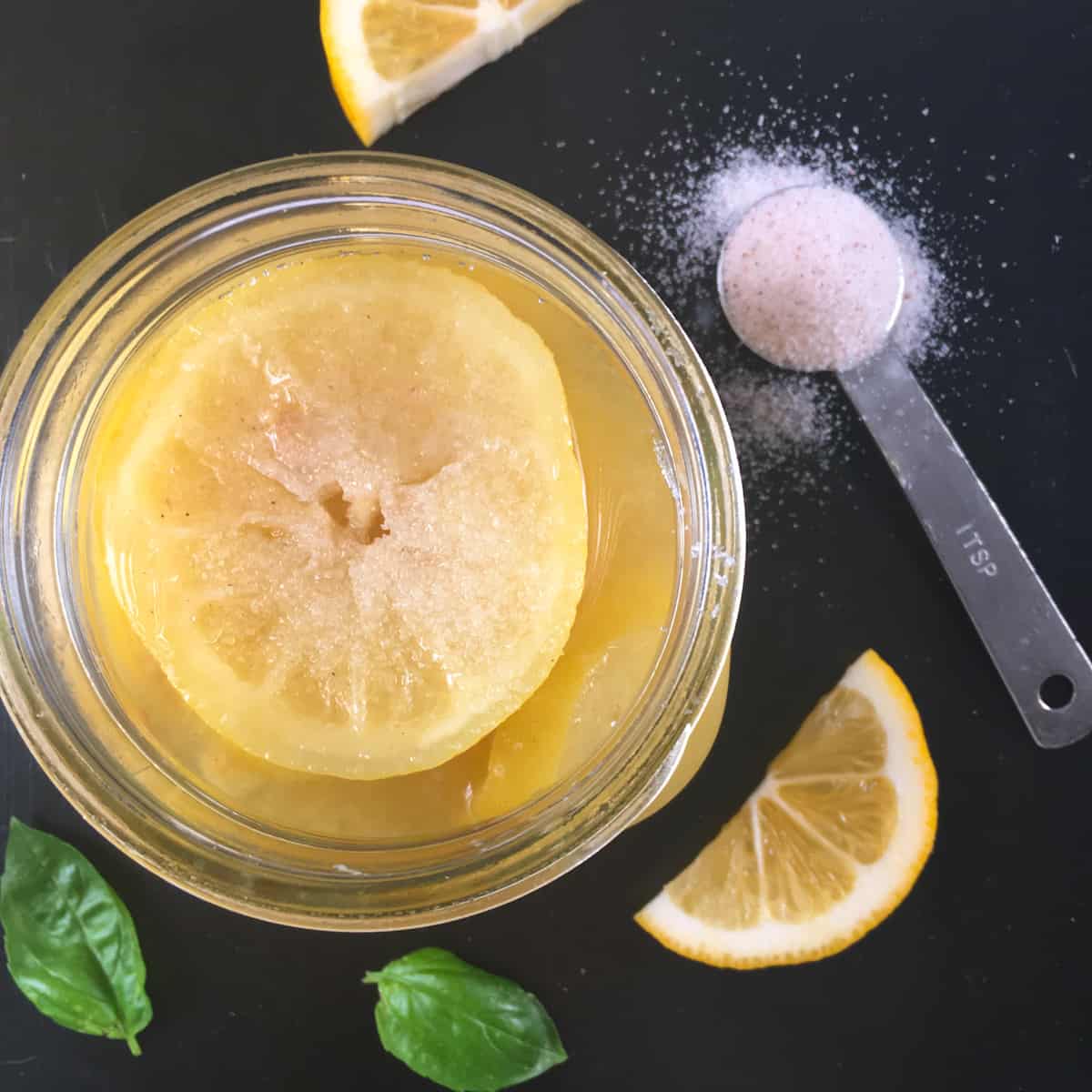
Want to save this post?
Enter your email below and we'll send it straight to your inbox. Plus you'll get great new recipes from us every week!
The term “preserved lemons” usually means salted lemons that are lacto fermented. However, there are different ways to preserve lemons. For example, a jar of lemon curd has likely been canned so it can be stored unopened at room temperature.
In general, there is no difference between pickled lemons vs preserved lemons. In some cases, however, pickled lemons are cooked in vinegar rather than salted. Lemons have a high acidity (low pH), so the risk of botulism is low with these various preservation methods.
Get the step-by-step instructions below or jump to the recipe card at the end of the post!
Table of Contents
- 🍋 Fermented Lemons Ingredients
- ➕ How to Make Fermented Lemons
- ⏲️ Preserved Lemon Slices Time and Temperature
- 🧂 How to Use Fermented Lemons
- 🍯 Fermenting Lemons with Sugar
- 🌡️ How to Store Fermented Lemons
- ⭐ Fermented Lemons Health Benefits
- 📖 Recipe Card
- 💭 Expert Tips from Dietitian Summer Yule
- 👩🏻🍳 Other Fermented Recipes
- 💬 Comments
🍋 Fermented Lemons Ingredients
What do you need to make fermented lemons? Here are the ingredients you need:
- 2 large fresh lemons (plus enough extra fresh lemon to make ¾ cup juice)
- 2 tablespoons canning salt, pickling salt, or fine grind sea salt
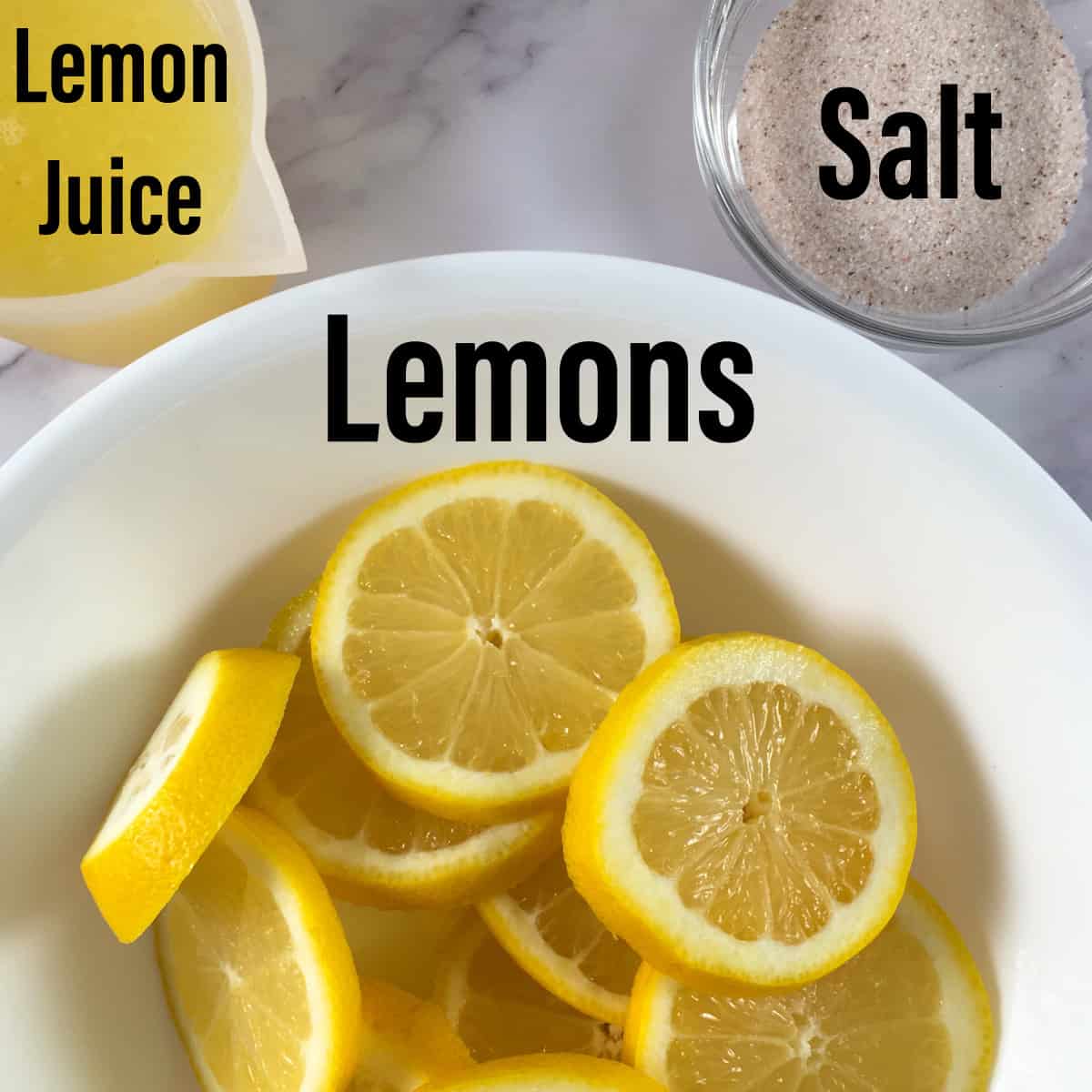
Do NOT use iodized salt or coarse grind salt for this recipe. Iodine can inhibit the fermentation process. Coarsely ground salt does not measure the same as finely ground and you will use too little.
If you want to be really specific regarding the amount of salt used, weigh the lemons and use 2% of this weight in salt. I find this unnecessarily fussy for lemon ferments and just use the measurements provided below. That said, weighing will get you the minimum amount of salt you need for a safe ferment.
I love using fresh Meyer lemons in this recipe. I find salted Meyer lemons to be fabulous-tasting and fragrant, and absolutely worth seeking out. If you can’t find them, regular lemons will work here too.
You will need more lemons than what you’ll slice into the jar. That’s because we’re making the brine with fresh lemon juice. Bottled lemon juice is not a good substitute for fresh juice in this recipe.
In short, you only need two ingredients for this recipe that you can find in most major supermarkets. How’s that for simple?
A wide-mouth pint-size glass mason jar is perfect for fermenting. The wide mouth fits most fermentation lids, while the jar’s “shoulders” help keep the lemons down.
I also recommend getting a fermentation kit with jar weights and air lock lids. These items go a long way in keeping your lemons submerged in brine and the moisture level in the jar just right. After getting a fermenting set, I’ve never had a ferment go bad.
➕ How to Make Fermented Lemons
Let’s learn how to ferment lemons! Here are the step-by-step directions:
- Before you begin, thoroughly clean and sanitize your canning jar in the dishwasher. You do not need to sterilize the equipment since you are not canning your lemon ferment.
- Rinse and dry your whole lemons. Juice enough lemons to yield ¾ cup of fresh lemon juice. I use a manual lemon juicer, but you can also juice by hand or use an electric juice extractor.
- Cut off the blossom and stem ends off two of the lemons. Cut the lemons into slices that are ¼-inch thick. Save the lemon ends for another recipe. (The reason we don’t use the ends is that those slices ferment a little more slowly.)
Hot tip: You could also cut the lemons into quarters, leaving them whole by not cutting them entirely through. I prefer to slice them since I generally chop them smaller anyway to use in recipes.
- Rub your lemon slices on all sides with salt. Don’t cut back on the salt in this recipe. The salt helps to prevent bad bacteria growth during fermentation.
- Pack the lemon slices tightly into a jar, but don’t overfill! The slices must remain below the lip of the jar. Use fewer lemons than you sliced, if needed.
- Cover the sliced lemons in the jar completely with lemon juice. You MUST fully submerge the lemons under the liquid to help prevent mold. You may or may not need all of the lemon juice you squeezed.
- Place the jar weight in the jar to help keep the lemons under the liquid. Screw on the air lock lid (adding water to the lid, if necessary, according to the type of lid used).
⏲️ Preserved Lemon Slices Time and Temperature
How long to ferment lemons? Ferment lemon for 4-5 weeks at room temperature (about 60-70 degrees Fahrenheit, or 16-21C). Refrigerate the lemons with salt at the end of the fermentation period.
If you are using an air lock lid and jar weight, you should not need to do anything with the lemons while they ferment. The one exception is if you are using an air lock lid with water, and your house is dry. In that case, you may need to add water to the lid periodically.
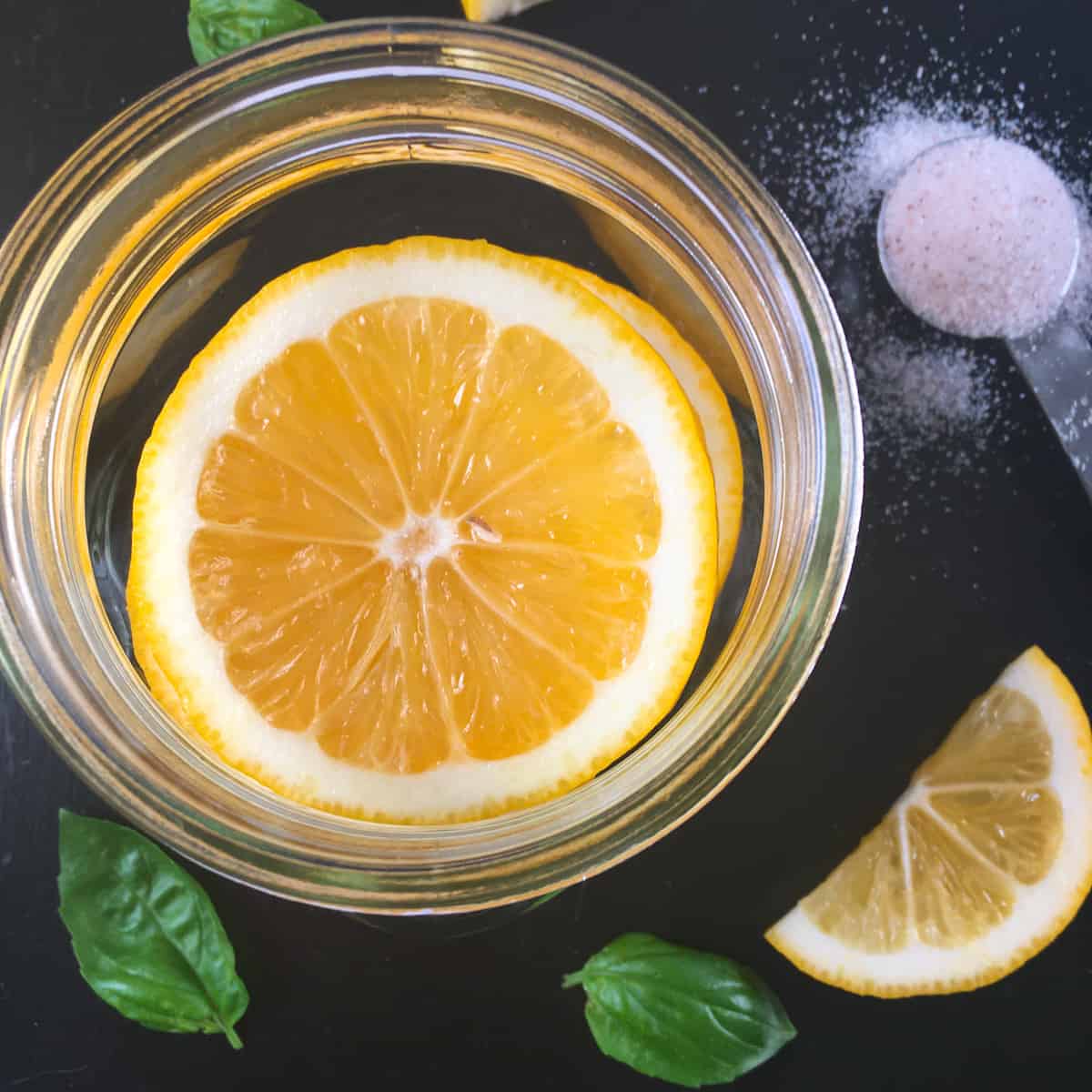
🧂 How to Use Fermented Lemons
What do you do with fermented lemons? I love to use preserved lemons instead of fresh when I am looking for more complex flavors. There are many recipes for fermented lemons out there, so think of the following suggestions as a starting point on your culinary adventures.
Fermented lemon peel is a popular ingredient in North African cuisine, particularly in Morocco. You will often find it featured in Moroccan chicken tagine recipes and stews. This Moroccan Chickpea Tagine is a really delicious way to use preserved lemons. My family loves it!

You can also use these fermented Moroccan lemons in marinades, salad dressings, sauces, and dips where you’d usually use fresh citrus fruits. Make a preserved lemon aioli or mayonnaise. Try blending a slice or two of preserved lemon into hummus in place of the lemon juice and lemon zest.
Preserved lemon is also a welcome addition to soups, lentil salads, and salmon dishes. Chop the lemon finely and use it as a tangy and salty substitute for capers.
Another idea is to blend a little fermented lemon into a puree and stir it into plain fermented dairy products. You can use lemon kefir or savory lemon yogurt as a condiment in many dishes.
You can use both the fermented lemon rind and pulp in recipes, though some only use the preserved lemon rind. I always use the entire fermented lemon when I cook.
Keep in mind that this ingredient provides robust flavor and a lot of salt. A little salt preserved lemon goes a long way in recipes! You can rinse your preserved lemons before adding to a recipe if you find them too salty.
🍯 Fermenting Lemons with Sugar
I’ve also seen recipes for Korean fermented lemons where the lemons are fermented with added sugar. The Korean lemon syrup created in the process is used to make fermented lemonade and fermented lemon tea. Fermented lemons in honey is another option.
Can lemons ferment into alcohol?
To make fermented lemons alcoholic, you may have to add ingredients to help lessen the acidity of the lemon solution. You would also likely need to use added sugar to get the process going.
The risk that this lemon ferment recipe will become an alcohol ferment is minimal. The amount of alcohol in homemade fermented lemon drinks (such as Finnish sima) is typically low.
🌡️ How to Store Fermented Lemons
How long do fermented lemons last? This preserved lemon slices recipe will keep in the fridge for 6-12 months, as long as they remain submerged in the brine.
Can preserved lemons be frozen? Yes, you can freeze preserved lemons for longer-term storage. However, since they keep for 6 months-1 year in the fridge, I’ve never had a need to freeze them.
Can preserved lemons go bad? Preserved lemons must be kept submerged in the brine in the refrigerator or they will become moldy. Use a jar weight when storing fermented lemons in the fridge to keep them from popping up above the liquid level.
As always, when in doubt, throw them out if you think the lemons have gone bad.
⭐ Fermented Lemons Health Benefits
Are fermented lemons good for you? It depends on the nutritional benefits you’re looking for! Preserved lemons are low in calories and add flavor that will enhance a variety of dishes. If you are on a low-sodium diet, however, foods fermented in salt are not a good choice.
You can reduce the sodium by rinsing the lemons before using. Sticking with fresh lemons will be a better option if you are on a medically-indicated low sodium diet.
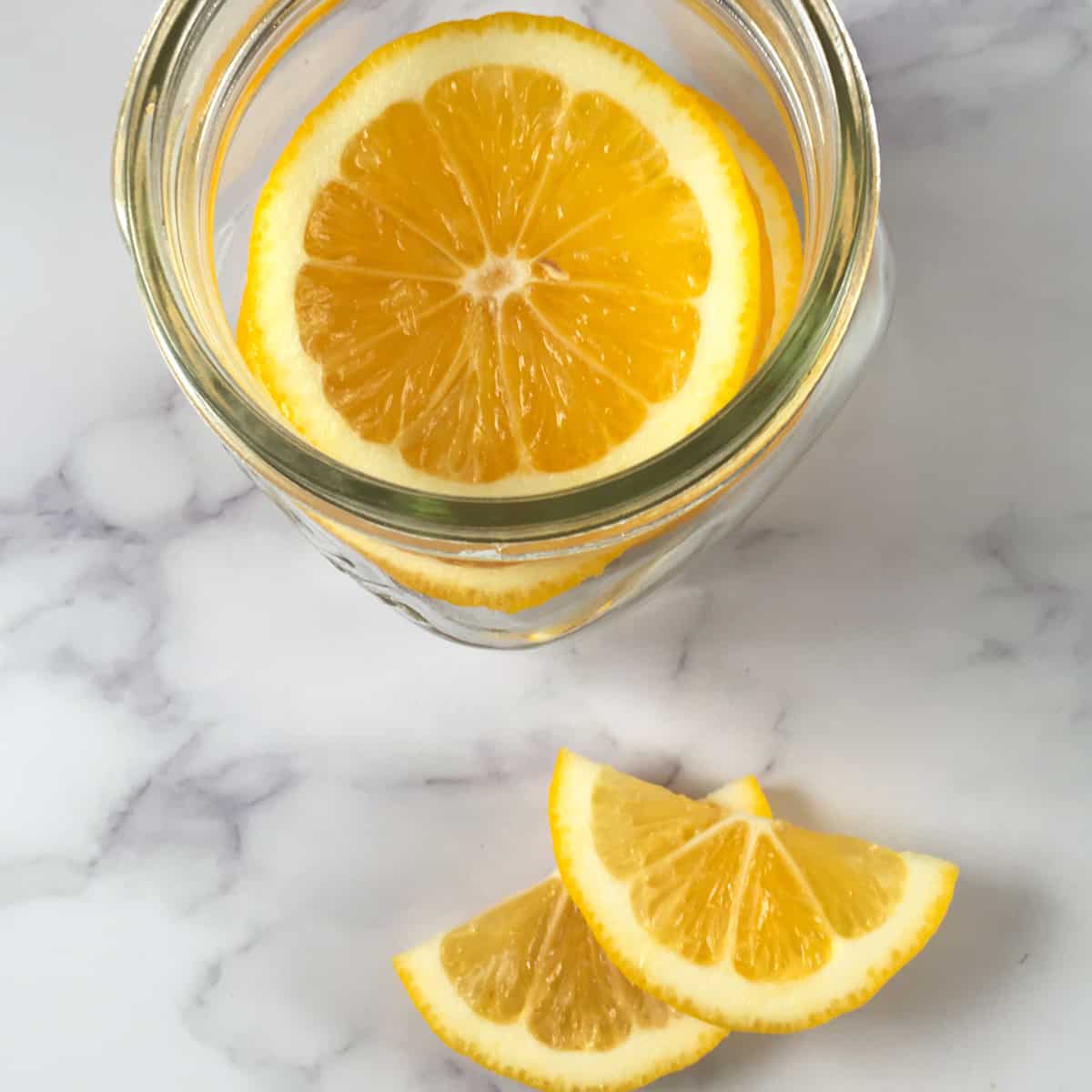
If you’re following a keto, low carb, vegan, gluten free, dairy free, soy free, or other special diet, fermented lemons may be a good fit. (Plus, they are major allergen-free!) A jar of fermented lemons would make a lovely gift for the foodies in your life.
📖 Recipe Card
Watch How to Make It!
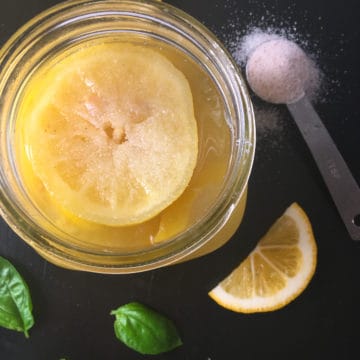
Fermented Lemons (Preserved Lemon Slices Recipe)
Ingredients
- 2 large lemons (Mayer lemons or other types of lemons; you may need more lemons to fill the jar if they are small)
- ¾ cup lemon juice, fresh squeezed (made from additional fresh lemons)
- 2 tablespoons pickling salt or finely ground sea salt
Instructions
- Clean and sanitize your canning jar in the dishwasher. Rinse and dry your whole lemons.
- Cut off the blossom and stem ends off two lemons. Cut the lemons into slices that are ¼-inch (0.64 cm) thick. Save the lemon ends for another recipe. (Infused water or candied lemon peels are two possibilities.)
- Juice enough of the remaining lemons to yield ¾ cup of fresh lemon juice.
- Rub your lemon slices on all sides with salt. Don’t cut back on the amount of salt in this recipe. It helps prevent bad bacteria growth during the fermentation process.
- Pack the salted lemon slices tightly into a jar, but don’t overfill. The slices must remain below the lip of the jar. Use fewer lemons than you sliced, if needed.
- Cover the sliced lemons in the jar completely with lemon juice. You may or may not need all of the lemon juice you squeezed.
- Place the jar weight (from the fermentation kit) in the jar to help keep the lemons under the liquid. Screw on the air lock lid. Add water to the lid if necessary, if the lid you have requires it.
- Allow your lemons to ferment for 4-5 weeks at room temperature (about 60-70°F/16-21°C). Compare the pics of fresh to finished lemons in this article for visual indicators of "doneness."
- If you are using an air lock lid and jar weight, you should not need to do anything with the lemons while they ferment. The one exception is if you are using an air lock lid with water, and your house is dry. In that case, you may need to add water to the lid periodically.
- Refrigerate the fermented lemons after the fermentation period has ended. They will keep in the fridge for 6-12 months, as long as they remain submerged in the brine. Enjoy!
Notes
💭 Expert Tips from Dietitian Summer Yule
This is a level 1 recipe (may help support fat loss). Fermented lemons are a low calorie, low carb, and low fat condiment. I don’t hesitate to classify this as a level 1 recipe. They are so versatile; I add them to a variety of healthy recipes. The one group that these fermented lemons are not appropriate for are individuals on low sodium diets. If you have a medically indicated sodium restriction, foods fermented in lots of salt are not the best option. That would include these preserved lemons, as well as traditionally fermented sauerkraut and pickles. As mentioned previously, the salt is necessary in this recipe for safe fermentation. If you are on a strict low sodium diet, I would stick to using fresh lemons in recipes. Usually we use lemon juice (and maybe a little lemon zest) when using fresh lemons in a recipe. With preserved lemons, we can use the whole lemon, rind, pith, and flesh. It’s a great way to help reduce food waste in the kitchen. The reason we can use the entire lemon is that the preserving process removes bitterness. Preserved lemons taste like everything you might love about lemons without being bitter. You get that wonderful citrus and floral thing going on, with a hit of umami from fermentation. Delicious! Nutrition information is for one serving of the recipe. Sodium content will depend on whether you rinse the fermented lemons before using and whether you use the brine. Vitamin C is reduced with heat and prolonged storage, so the amount listed here is likely an overestimate.
nutrition info disclaimer
All recipes on this website may or may not be appropriate for you, depending on your medical needs and personal preferences. Consult with a registered dietitian or your physician if you need help determining the dietary pattern that may be best for you.
The nutrition information is an estimate provided as a courtesy. It will differ depending on the specific brands and ingredients that you use. Calorie information on food labels may be inaccurate, so please don't sweat the numbers too much.
"To taste" means to your preferences, which may have to be visual to follow food safety rules. Please don't eat undercooked food x
Nutrition
👩🏻🍳 Other Fermented Recipes
Looking for other foods to ferment? Here some more recipes for ferments you may enjoy:
- Fermented Red Cabbage Sauerkraut
- Lebanese Pickles Recipe
- Spelt Flour Sourdough Starter
- Instant Pot Almond Milk Yogurt
Join our community! Subscribe for all of the latest and greatest recipes, and follow me on Facebook, Pinterest, Instagram, and YouTube!

Hello! I'm Summer, a registered dietitian and home chef who loves to cook, eat, and create high quality content for you! Every recipe on this site has been tested by me to help ensure your success in the kitchen. All eaters are welcome here 🙂


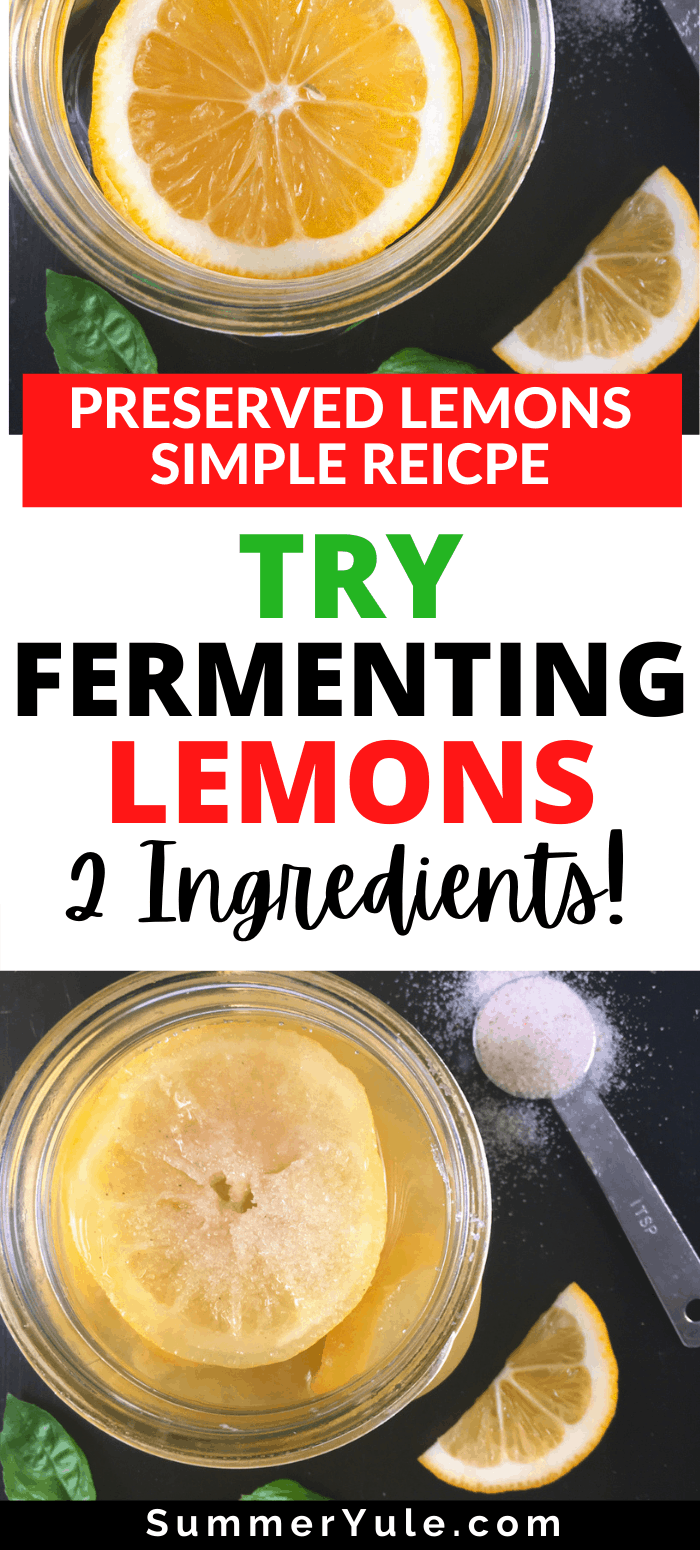
ann says
I love fermenting lemon with very fresh ginger. It's a fantastic flavor combination and, since ginger is easily lacto-fermented, I find it helps speed up the process with lemons. I like making extra brine to use in salad dressings, etc. Adding a bit of sugar before using creates a delicious shrub for a fizzy cocktail. Lots of uses! Thanks!
Summer Yule says
Hi Ann, Your suggestions all sound amazing! I'll be sure to add some ginger next time I make a batch. Thank you for visiting and leaving feedback 🙂